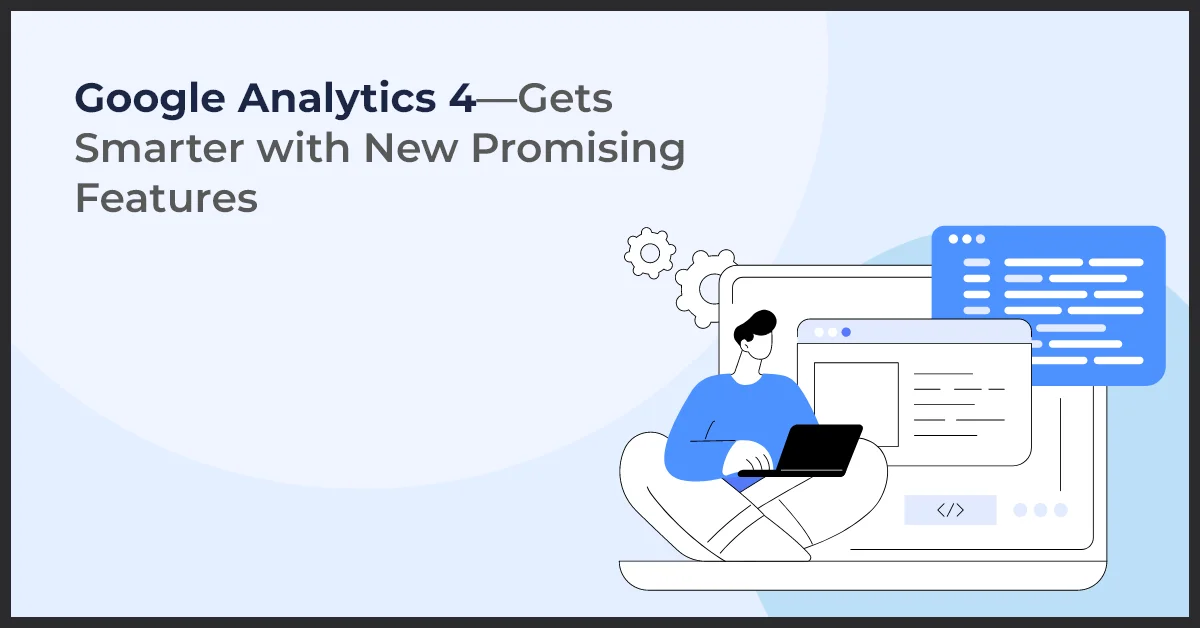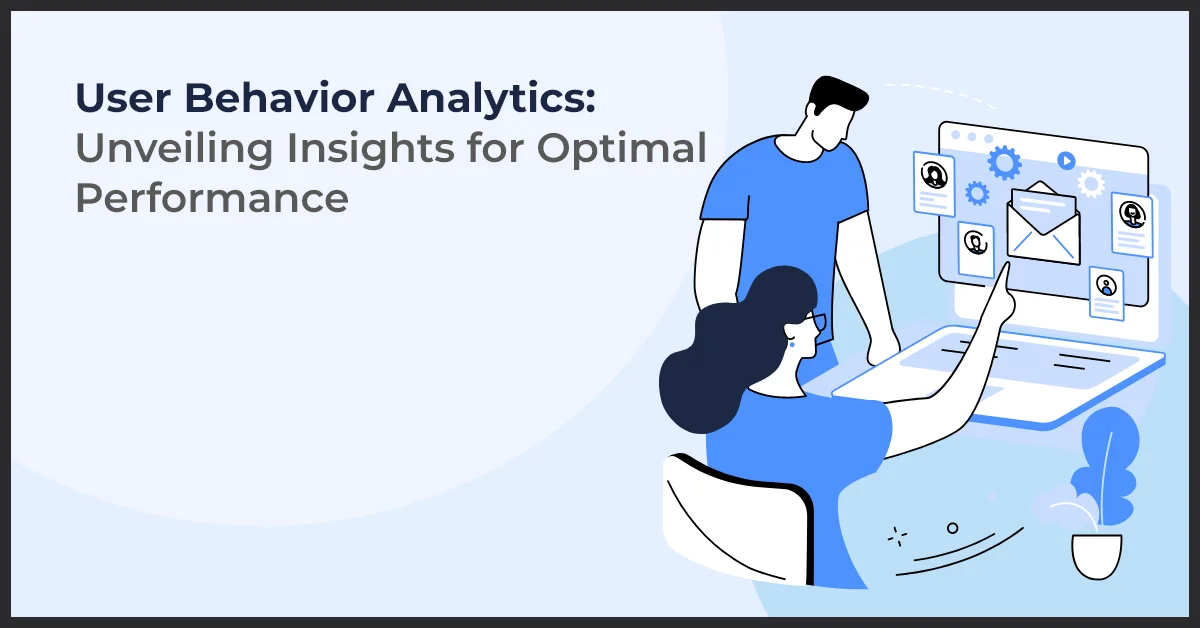Google Analytics 4—Gets Smarter with New Promising Features

Published on: November 12, 2020
Updated on: April 16, 2024
342 Views
- Analytics
9 min read
For a tool that helps analyze business growth and take it forward, businesses across the world trust Google Analytics (GA). They hold complete confidence in its potential to track user behavior and customer experiences. And yet, these millions of businesses demand more from Google Analytics to be able to measure returns on their digital marketing investment.
According to a recent survey, despite GA’s ability to determine your traffic source, examine website performance, and track user activity, marketers still fail to get a 360 degree view of customers and extract far-reaching insights on them.
This is why even though 84% of decision-makers consider cross-platform analytics “very important,” not more than 43% have actually implemented cross-platform analytics tools.
Consumer sentiment and behavior has shown a paradigm shift in how they interact with brands and make buying decisions. Google Analytics could not seem to match the pace and meet marketers’ expectations with its existing highlights.
Hence, the latest release from Google Analytics—Google Analytics 4.
What’s new in Google Analytics 4?
The latest GA version is a more streamlined tool with various AI-based advances such as better data controls and comprehensive predictive user insight.
The new release is an extended version of the App + Web property that was launched by Google in beta last year.
At the core of GA 4 sit machine learning and privacy concerns. The aim is to provide you with a multi–platform and device view of the user without breaching their privacy even when any industry changes are introduced.
Therefore, you can make more informed decisions as well as every penny invested count and then some.
Here is a detailed view of the major features introduced in the new Google Analytics:
Detailed and predictive insights
Machine learning is known to Analytics for quite some time now. Then what’s different with Google Analytics 4?
With the insights that GA 4 can provide, you will:
- Get automatic alerts to the ever-changing buying trends.
- Be notified about an increase or decrease in a product’s demand, for instance, if your customers’ needs change.
With the new predictive metrics being introduced, you will be able to:
- Estimate potential revenue from a particular group of customers.
- Predict users’ future behavior, determine high value customers, and find more efficient ways of valuable customer retention.
Enhanced integration with Google Ads
The new Google Analytics can be easily and deeply integrated with Google Ads, which is what allows you to:
- Create audiences that only come across your happy customers across the web.
- Automatically update your audience list when a user takes an action on the web but ends up making a purchase via the app. Therefore, you will not retarget the user with ads.
The upgraded version’s ability to examine web and app interactions at once further allows you to:
- Analyze conversion reports from YouTube engaged views from both in-app and on the web.
Holistic view of the customer journey
Considering how marketers have been unable to gain a complete picture of user engagement across devices and channels, Google aims to provide a holistic view with its latest Analytics release.
Rather than focusing on device- or channel-based measurement, it aims at measuring customer centricity on the whole. You can
- Learn how your customers interact with your brand as you provide your user ID or a unique Google signal to remove any duplicate user data before targeting them through ads.
- Look into particular aspects of a customer’s journey. Therefore, you can understand their complete lifecycle and make decisions in real time.
Granular data controls
Meticulous data controls is another extraordinary feature of the latest Google Analytics, which allows you to manage collection and retention of user data in improved ways.
Google has introduced consent mode for websites that need users’ permission to gather their data in Analytics. This way, Google has made a wonderful effort to make Analytics a valuable product for your customers or users too.
Key Features of Google Analytics 4
A. Event Tracking
Google Analytics 4 offers the ability to track specific events on websites and mobile apps. Examples of these events include button clicks, form submissions, and video plays. This feature allows businesses to gain valuable insights into how users interact with their digital assets.
B. Enhanced Measurement
With Google Analytics 4, businesses can benefit from automatic event tracking for actions like scrolling or file downloads. Additionally, this version introduces additional measurement options, enabling businesses to capture more detailed data about user interactions and behaviors.
C. User-Centric Data
Google Analytics 4 focuses on user-centric measurement, providing businesses with a better understanding of the user journey. This includes analyzing user behavior across multiple devices and platforms, allowing businesses to gain insights into how users engage with their brand across various touchpoints.
D. Machine Learning-Based Insights
Leveraging machine learning algorithms, Google Analytics 4 offers advanced insights and predictions. Businesses can benefit from features like predicting user churn or identifying high-value customers, empowering them to make data-driven decisions for their marketing and business strategies.
E. Advanced Analysis Capabilities
Google Analytics 4 provides advanced analysis capabilities, such as path analysis. This feature allows businesses to understand user navigation behavior on websites or apps, helping them optimize user journeys and improve overall user experience.
F. Cross-Platform Tracking
With Google Analytics 4, businesses can track user interactions across various platforms and devices. This includes tracking web interactions, mobile app interactions, and even offline interactions. By capturing data from multiple channels, businesses can gain a comprehensive view of their customer interactions.
G. Privacy-Centric Features
Addressing privacy concerns, Google Analytics 4 offers data deletion controls and customizable data retention periods. These privacy-centric features give businesses more control over their data and enhance privacy protection for their users.
H. Integration with Other Google Products
Google Analytics 4 seamlessly integrates with other Google products, providing businesses with deeper insights. This integration allows businesses to explore cross-platform data sharing capabilities, enabling them to leverage data from various sources to gain a holistic understanding of their audience and marketing efforts.
E-Commerce Tracking
Upgrade Your Online Business Performance with Google Analytics 4
Maximize your e-commerce efforts with the improved e-commerce tracking capabilities of Google Analytics 4. This advanced analytics tool provides accurate measurement of your online sales activities, empowering you with valuable insights.
With GA4, analyzing online purchase activities becomes more efficient than ever. It allows you to track and comprehend the customer journey in detail, providing a comprehensive view of your e-commerce performance. Gain valuable data on transactions, revenue, and conversion rates at a glance.
By leveraging the power of GA4, you can identify the key drivers that influence purchasing decisions, enabling you to make data-driven decisions to optimize your online business. Understand customer behavior, track user engagement, and identify opportunities to enhance user experience and drive conversions.
Stay ahead of the competition by utilizing GA4's cutting-edge e-commerce tracking features. Gain valuable insights into cart abandonment rates, average order value, and sales performance of individual products or categories. This knowledge helps you tailor your marketing strategies and product offerings for maximum effectiveness.
Make sense of your e-commerce data effortlessly with GA4's intuitive interface. Create custom reports and dashboards to suit your business needs, presenting data in a way that is both visually appealing and easy to understand. Visualize your data with user-friendly charts and graphs, enabling you to spot trends and patterns quickly.
Unlock the full potential of your online business with Google Analytics 4's e-commerce tracking capabilities. Start measuring, analyzing, and optimizing your e-commerce performance today.
Benefits of Google Analytics 4 for Businesses
Google Analytics 4 (GA4) is not just another analytical tool; it is a game-changer for businesses looking to gain a competitive edge. With a host of powerful features and functionalities, GA4 offers a wide range of benefits that can revolutionize your business strategy.
1. Making Data-Driven Business Decisions
GA4 provides businesses with advanced analytics and insights that can assist in making data-driven decisions. It allows you to collect and analyze user behavior across various platforms, helping you understand your audience better than ever before. By leveraging the power of GA4, businesses can optimize their marketing efforts, improve customer experiences, and drive growth.
2. Impact on Marketing Strategies
Understanding the impact of your marketing strategies is crucial for the success of any business. GA4 provides comprehensive reporting and attribution modeling that allows you to track the performance of your marketing campaigns with precision. By analyzing the data, you can identify the most effective channels and optimize your marketing budget for maximum ROI.
3. Effective Customer Understanding and Targeting
GA4 comes equipped with enhanced user journey tracking and advanced machine learning capabilities. This enables businesses to gain a deep understanding of customer behavior, preferences, and interests. With this valuable insight, you can develop targeted marketing campaigns and personalized experiences that resonate with your customers, ultimately driving higher engagement and conversions.
With its extensive range of features tailored for businesses, Google Analytics 4 is the tool you need to unlock your business's true potential. By harnessing the power of GA4, you can make informed decisions, optimize your marketing efforts, and effectively target your customers - giving your business the competitive advantage it needs in today's digital landscape.
In addition, you will be able to:
- Respond to increasing and varying demands of customers as well as to the technology norms that keep changing for maintaining user privacy.
- Gain complete control over ad personalization, thereby being able to decide whether you want to use Analytics data for ad optimization or limit it to measurement.
What more can be expected of GA 4?
What’s unimaginable is how Google doesn’t fail to remain future-proof in the developments it makes. Google Analytics 4 is no different. As third-party cookies are being discontinued, Google has introduced machine learning to the upgrade to fill any possible data gaps.
Apart from this, you can leverage:
- Codeless event tracking which helps cut how companies perform Google tracking code to measure user activity and behavior such as video views.
- Data deletion tool that eliminates any security issues when users do not want to provide their action information anymore.
Hence, with Google Analytics 4, you can effectively evaluate all your marketing efforts.
Makes it a deal to steal yet?
A smarter Analytics tool will allow you to meet customer expectations, no matter how much uncertainty the future holds. With granular controls over data, you can use customer data better to only improve your digital marketing strategy down the line.
With the introduction of GA 4, Google recommends you either use it for any new property or use both Google Analytics 4 and Universal Analytics correspondingly.
If you want a complete understanding of the new Analytics, consult our experts at Growth Natives and we will help you determine and improve how your customers interact with your brand.
Frequently Asked Questions
Google Analytics 4 (GA4) introduces several new features, including enhanced predictive insights, more granular data controls, and a stronger focus on cross-platform measurement.
Google Analytics 4 offers improved user-centric measurement, better integration with Google Ads, and more advanced machine learning capabilities for deeper insights and predictive analytics.
Google Analytics 4 is positioned as the future of analytics by Google, offering more advanced features and capabilities compared to Universal Analytics (the previous version).
Some of the biggest changes in GA4 include the shift towards event-based tracking, the introduction of the enhanced measurement feature for better data collection, and the emphasis on privacy with more granular data controls.



